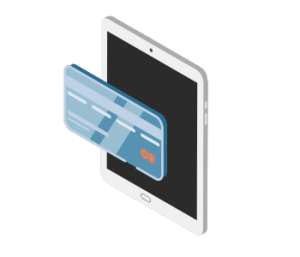Virtual terminal payments are a secure way to electronically process credit or debit card transactions for sales made over the phone or by mail. For card-not-present transactions, where the cardholder can’t tap or insert their card in a physical terminal, a virtual terminal can be used instead.
What is a virtual terminal and how does it work?
A virtual terminal for card payments typically includes a software component and a hardware component.
The hardware component is typically a mobile device, such as a smartphone or a tablet. There’s no need for a physical Point of Sale (POS) machine.
 The software component is the application that’s run on the hardware device specifically for cardholder data entry. This program is where the operator will key in the card number, expiration date, and zip code.
The software component is the application that’s run on the hardware device specifically for cardholder data entry. This program is where the operator will key in the card number, expiration date, and zip code.
Because the software component is typically a web-based application, virtual terminal payments do require the user to be connected to the Internet. However, they do not require a specific operating system, which means they can be used on Apple, Android, or non-branded hardware.
How to use a virtual terminal for credit card payments
Setting up a virtual terminal is typically the most complicated part. You’ll first need a merchant account and a bank account. You’ll need to work with a Payment Service Provider (PSP) who offers a virtual terminal solution, and there may be coding required to interface with the new terminal. Configuration is often handled on the back end by the PSP.
Once configured, you can use your virtual terminal to accept all major credit and debit card brands, including Visa, Mastercard, American Express, and Discover.
An operator (such as a sales rep or a customer service agent) opens the virtual terminal and enters the customer’s card data. Alternatively, the customer can enter it themselves using IVR. Or, if you’re using a virtual terminal that supports remote tokenization, you can choose a saved method of payment when you sell to returning customers, eliminating the data entry step to make the process even easier. From there, click a button to submit the transaction and wait for the response.
The data is sent from your virtual terminal to your authorization network. You’ll receive confirmation that the transaction has been approved (or an error message if the transaction is declined); from there, you can continue on with the rest of the transaction.
Virtual terminal payments pay out the same way as other transactions. Once the transaction is authorized and the batch is settled, the money will be deposited into your bank account the same way it would be for a physical terminal or e-commerce purchase.
Where to use your virtual terminal
Virtual terminal payments are often used in call centers and back offices. However, there are other creative use cases where mobile payments can be extremely convenient. For instance, you can process a payment on a virtual terminal on a tablet while at a trade show, delivering to a customer’s jobsite, or working outside sales. It’s a great solution for running your business anywhere.
Integrating your virtual terminal with your other applications
This isn’t mandatory, but it can make your transactions much simpler.
If you integrate your virtual terminal with your other back-office applications (such as your ERP system or a stand-alone order entry program), you can seamlessly pass data from one system to the next. You don’t, for instance, have to key in the amount if that data can be retrieved from the transaction record in your ERP. Similarly, after the transaction is approved, you don’t have to go back to your ERP and it with the payment details; everything is seamlessly synced on a single record.
Virtual terminal payment processing fees
When you process a card-not-present transaction, you’ll typically have to pay a higher fee than you would if you were processing a card-present transaction. (This is because card-present sales require the user to be in physical possession of the card, reducing the chances of fraud.) However, the convenience of being able to take payments over the phone and by mail make the fees a worthwhile cost of doing business.
Some virtual terminals also charge a per-transaction fee for any sale processed through the gateway. At Curbstone, however, we don’t charge per-transaction fees for sales that go through our software (be it via virtual terminal or physical terminal); this is just one of the ways we make payment processing more affordable for merchants.
Security considerations for virtual terminal credit card processing
Virtual terminals – like any other solution you use to process credit card payments – come with their own security and compliance requirements.
Any device that you use will be considered in scope for your PCI compliance audit, as will the Wi-Fi connection that you use to connect that device to the internet. That’s why at Curbstone, we recommend that merchants designate specific devices to use exclusively as virtual terminals, and not use these devices for any other purpose. You may be able to include just those devices – and just that Wi-Fi connection – in your security audit, without cardholder data touching any other part of your system.
Learn more about virtual terminal payments
Ready for a faster, more secure approach to card-not-present credit card processing? Contact us today to learn more about virtual terminal payments.

